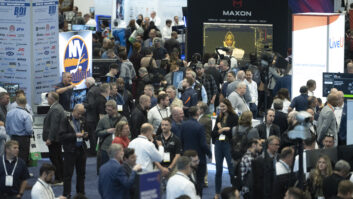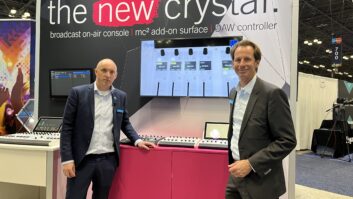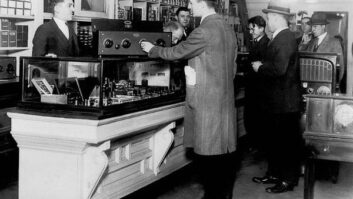He’s been a fixture in the broadcast industry for four decades. Now Bob Surette has decided to hit the links.

On the shop floor at Shively Labs in 1984, Bob Surette, left, and Ed Shively, far right, inspect cavities destined for the 441 site, a multi-channel tower facility built by Guy Gannett Communications in the Miami area. The combiner was the first band-pass filter system that used square cavities and group delay equalizers in the United States, Surette said. He spent 38 years at Shively starting in 1973, with a brief interruption to work at nearby Dielectric. He returned to Shively and remained for the rest of his career, an industry constant for both clients and co-workers.
At age 69, he retires with a legacy of many many antenna projects, presentations at SBE chapters, personal warmth and great stories.
Surette developed an early interest in electronics, but the path to a career in antenna engineering at Shively Labs was not a straight one. It started at age 12 when he was growing up in Reading, Mass.
RÉSUMÉ BLITZ
“A neighbor was a ham radio operator. His sons and I helped him build an open-wire 6-meter antenna, which was strung up between two houses,” Surette said. This early exposure sparked an interest in electronics, antennas and, briefly, amateur radio. “I put together a few Heathkits and began to study for my amateur license. I got up to 13 words per minute on the code, but eventually lost interest.”
He served four years in the Navy, much of that time spent doing electronics repair, including stops in Florida, Tennessee, Maine and Virginia. After leaving the service in 1969, he enrolled at Lowell Technical Institute, earning a BSEE degree. The program included electronics and computer programming, which at that time meant mainframes, writing code in Fortran and transferring it onto punch cards. Surette graduated in 1973.
At least in the short term, his academic efforts seemed to be for nothing. “The economy was in a downturn when I finished school. I sent out countless résumés but got no job offers,” he said. Eventually Surette did land a position in Hartford, Conn., writing programs in Fortran for an insurance company.
But the résumé blitz did produce further results. One landed on the desk of Ed Shively, an antenna engineer. He had worked for RCA and Dielectric but set out on his own in 1963 to form Shively Labs in Raymond, Maine. The company needed a Fortran programmer to write programs for the pattern range.

Surette, right, discusses cross-polarization following a day at the NAB Show.ROUND TRIP
Surette signed on in December of 1973. “Getting a program done was a tedious process in those days,” he said. “I had to write the programs out on paper, then drove to Portland, where they were put onto punch cards and then the program was run.”
That hard work would pay off. The next year the Canadian government launched ACP, the Accelerated Coverage Program, where communities with more than 500 inhabitants would get FM coverage. Shively was in on the ground floor and eventually fulfilled 80 percent of the work.
Around this time, Surette’s job description also began to expand. “We were short-handed in those days, and I went from Fortran programmer to installation engineer rather quickly.” Surette spent so much time up north that he had to get a work card from the Canadian government.
This rapid transition in job functions was possible in large part thanks to Ed Shively’s tutelage.
“Ed was quite a mentor, and he engrossed me in everything that he did.” Shively’s skills ranged from the theoretical to the practical. “He taught me about wave motion, and got me to visualize what would happen before we actually ran the pattern.” Surette said that Shively was a visionary, designing and building one of the first directional FM antennas and doing much of the pioneering work for circularly-polarized antennas. Shively also built the first circularly-polarized TV antenna for a station in Altoona, Pa.
On the practical side, Ed Shively was a hands-on guy who did a lot of the fabrication himself, building antennas and tuned cavities to exacting tolerances. These skills, too, passed along to Bob Surette.
He worked for Shively for six years, then moved up the road to work for nearby Dielectric; but the stay was short.

Around 1976, Surette, under the tutelage of Ed Shively, designed this panel antenna, which was installed in North Bay, Ontario. At the time it was the most omnidirectional panel antenna on the market. “Shortly after I left, Ed became seriously ill, and decided to sell the company. Shively Labs was purchased by Howell Labs in 1980, and they needed someone to fill Ed’s role as an RF engineer. I was approached by a headhunter and asked to return, and they hired me back.”
The ACP work had been a boon to Shively in the 1970s but it also meant that it had neglected the U.S. antenna market somewhat. Surette’s job description expanded to include promotion and public relations.
He joined the Society of Broadcast Engineers, Association of Federal Communications Consulting Engineers and the Institute of Electrical and Electronics Engineers; he toured the country making numerous presentations about FM antennas and doing Ennes workshops for SBE.
Through this work, Surette’s name became known around the country, and ultimately, around the world.
HE “SAVED MY BACON”
After 40-odd years, there are a lot of Bob Surette stories.
Mike Pappas of Pappas Consulting LLC recalls Surette as a wealth of knowledge. “He has saved my bacon on countless occasions and was one of the brightest guys in the industry. Every time I got on the phone with him or spent time with him at a show, my IQ went up by 10 points. He built me a raft of great antennas that worked perfectly and made me look good, no small feat.”
Jonathan Clark, sales manager for Shively Labs, believes Surette will be best remembered for his communications skills.
“Bob had a way of dealing with customers that was enviable to most people. He could quickly assess someone’s knowledge of antennas and explain thing at exactly the right level.” Clark said this is not an easy thing to do, because much of antenna engineering is something of a black art.
“He was so good with customers, we felt it was important to get him out in front of people even more,” Clark said. So Surette began giving papers and doing presentations for the SBE and IEEE. “He was out there so much, most people thought he owned the company.”

Surette, right, talks at the 2013 fall Radio Show with Nathan “Briton” Smith of ADX Communications over a single-bay 6828 FM antenna.
Credit: Photo by Jim Peck Clark says Surette remained humble and gracious. “When taking questions, he would be quick to say, ‘Let me check with my people and get back to you,’ if he didn’t know the answer. He truly appreciated the support people behind him.” Clark appreciates his colleague’s ability to excite others about antennas and to create an understanding about what goes in to making them work properly.
Jerry Dowd, Greater Media market chief for WBT(AM) and WLNK(FM) in Charlotte, N.C., said, “We had some issues with a particular Shively antenna. I asked Bob how many others they had built in that configuration. He said that was the first and last one. I asked him if that made it a collector’s item. He replied that it depends on what you collect.”
For stations in the New England states, the local connection to Bob Surette and Shively has been especially important.
Ira Wilner, chief engineer of Monadnock Radio Group in Keene, N.H., said, “Bob has always gone out of his way for customers. While I was working as a contract engineer for WKNE(FM) in Keene, we had an antenna failure one night. The next morning I called Bob, and gave him the details of our antenna. That day, they fabricated a temporary antenna and had it tested. A couple of our guys drove over to Bridgeton that night in a pickup truck and brought it home.
“Antenna and line went up the next morning, and WKNE was back on the air with low power.”
HITTING THE LINKS
After retirement, what comes next for Surette?
“First off, I want to play a lot of golf. Beyond that, the plans aren’t as definite.” He has accepted a position teaching Algebra II at Bridgton Academy. On his to-do list are renovating his primary residence to sell, and moving into a smaller house and upgrading it.
“It will be nice to stay at home, although I’m not entirely sure how to do that.” One thing is certain: “I don’t want to travel any more. I’ve done that all my life.”
He lives in Harrison, Maine, with his wife of almost 30 years, a few miles from the Shively offices. He has two grown children.
Staying in touch with colleagues is important. He invited them to send email to [email protected]. “I hope to hear from colleagues and friends I’ve made over the years. … I fell into this job 42 years ago, and now I’m sure I’ll fall into something else.”












